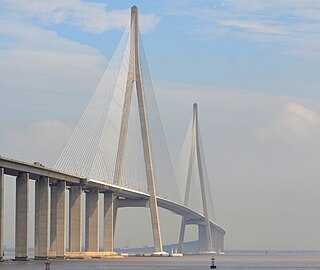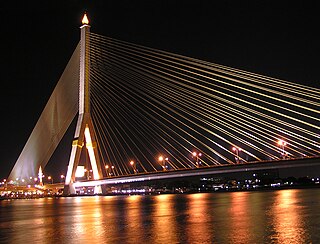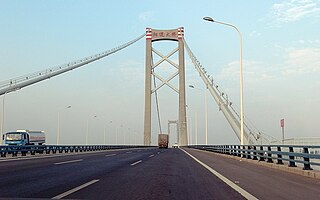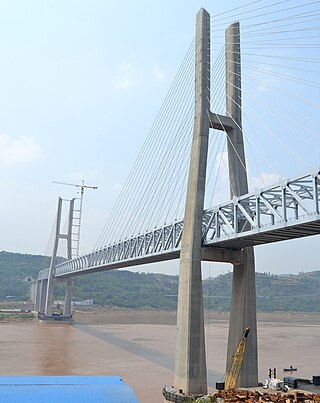
A cable-stayed bridge has one or more towers, from which cables support the bridge deck. A distinctive feature are the cables or stays, which run directly from the tower to the deck, normally forming a fan-like pattern or a series of parallel lines. This is in contrast to the modern suspension bridge, where the cables supporting the deck are suspended vertically from the main cable, anchored at both ends of the bridge and running between the towers. The cable-stayed bridge is optimal for spans longer than cantilever bridges and shorter than suspension bridges. This is the range within which cantilever bridges would rapidly grow heavier, and suspension bridge cabling would be more costly.

The Runyang Yangtze River Bridge is a large bridge complex that crosses the Yangtze River in Jiangsu Province, China, downstream of Nanjing. The complex consists of two major bridges that link Zhenjiang on the south bank of the river and Yangzhou on the north. The bridge is part of the Yangzhou–Liyang Expressway. Construction of the bridge complex began in October 2000 and was completed ahead of schedule. The bridge cost 5.8 billion Yuan. The complex opened to traffic on April 30, 2005. The total length of the bridge complex is about 35.66 kilometres (22.16 mi). In between the two bridges is the island of Shiyezhou.

An extradosed bridge employs a structure that combines the main elements of both a prestressed box girder bridge and a cable-stayed bridge. The name comes from the word extrados, the exterior or upper curve of an arch, and refers to how the "stay cables" on an extradosed bridge are not considered as such in the design, but are instead treated as external prestressing tendons deviating upward from the deck. In this concept, they remain part of the main bridge superstructure.

The Sutong Yangtze Bridge is a cable-stayed bridge that spans the Yangtze in China between Nantong and Changshu, a satellite city of Suzhou, in Jiangsu province.

The Rama VIII Bridge is a cable-stayed bridge crossing the Chao Phraya River in Bangkok, Thailand. It was built to alleviate traffic congestion on the nearby Phra Pinklao Bridge. Construction of the bridge took place from 1999 to 2002. The bridge was opened on 7 May 2002 and inaugurated on 20 September, the birth anniversary of the late King Ananda Mahidol, after whom it is named. The bridge has an asymmetrical design, with a single pylon in an inverted Y shape on the west bank of the river. Its eighty-four cables are arranged in pairs on the side of the main span and in a single row on the other. The bridge has a main span of 300 metres (980 ft), and was one of the world's largest asymmetrical cable-stayed bridges at the time of its completion.

The Wuhu Yangtze River Bridge is a combined highway and railway bridge over the Yangtze river. The bridge is located in Wuhu, Anhui, China, and was completed in 2000. The cable-stayed bridge consists of a 312 metres (1,024 ft) main span and two 180 metres (591 ft) side spans and has, together with all approaches, a total length of 10,521 metres (34,518 ft). The bridges carries four lanes of the G5011 Wuhu–Hefei Expressway on the upper deck and the dual-track Huainan Railway on the lower deck.

The Second Wuhan Yangtze River Bridge is a bridge across the Yangtze River in Wuhan, Hubei province, China. It is located northeast (downstream) of the historic central area of the city's Hankou District and is the northern crossing for the Inner Ring Road. It is a cable-stayed bridge built of pre-stressed concrete, and has a central span of 400 metres (1,300 ft). It is 4.678 kilometres (2.907 mi) in length and is 26 metres (85 ft) wide. Its main bridgeheads are 90 metres (300 ft) high each, pulling 392 thick slanting cables together in the shape of double fans, so that the central span of the bridge is well-balanced on the piers and the bridge's stability and vibration resistance are ensured.

The Shanghai Yangtze River Tunnel and Bridge is a bridge–tunnel complex across the south fork of the Yangtze River near the river mouth in Shanghai. The tunnel connects the Pudong District of Shanghai on the south bank of the river with Changxing Island, while the bridge connects Changxing Island with Chongming Island. In combination with the Chongqi Bridge, which connects Chongming Island to the north bank of the Yangtze, the bridge–tunnel complex forms the final crossing of the Yangtze before it empties into the East China Sea.

The bridges and tunnels across the Yangtze River carry rail and road traffic across China's longest and largest river and form a vital part of the country's transportation infrastructure. The river bisects China proper from west to east, and every major north–south bound highway and railway must cross the Yangtze. Large urban centers along the river such as Chongqing, Wuhan, and Nanjing also have urban mass transit rail lines crossing the Yangtze.

The Yangluo Yangtze River Bridge is a suspension bridge over the Yangtze River in Wuhan, Hubei, China. With a main span of 1,280 metres (4,200 ft), at its opening it was tied with the Golden Gate Bridge as the ninth longest suspension bridge in the world. The bridge carries the G70 Fuzhou–Yinchuan Expressway and G4201 Wuhan Ring Expressway over the Yangtze River and provides easy access to both sides of the river as part of a larger plan to promote development in the eastern portion of the city. Construction on the bridge began on November 4, 2003, and it opened to traffic on December 26, 2007.

Anqing Yangtze River Bridge is a cable-stayed bridge spanning 1,040 metres (3,410 ft) over the Yangtze River at Anqing, Anhui Province in eastern China. The bridge is 31.2 metres (102 ft) wide and carries four lanes of traffic on the G50 Shanghai–Chongqing Expressway between Anqing north of the river and Dongzhi County in Chizhou prefecture to the south. The bridge opened on December 27, 2004 and was the 35th bridge across the Yangtze River between Yibin and Shanghai. The bridge required investment of ¥1.3174 billion.

The Zhongzhou Yangtze River Bridge is a cable-stayed bridge over the Yangtze River in Zhong County of Chongqing, China. Completed in 2009, the bridge carries traffic on the G50 Shanghai–Chongqing Expressway.

The Fengjie Bridge is a cable-stayed bridge which crosses the Yangtze River in Fengjie, Chongqing, China. Completed in 2005, it carries 4 lanes of traffic on the S201 provincial road. The bridges main span measures 460 metres (1,510 ft) which places it among the longest cable-stayed spans in the world. The bridge was constructed 110 metres (360 ft) above the original river however the reservoir created by the Three Gorges Dam has increased the height of the water below the bridge and the clearance is vastly reduced.

The Hanjiatuo Yangtze River Bridge is a cable-stayed railway bridge over the Yangtze River in the Fuling District of Chongqing, China. The bridge carries the Chongqing-Lichuan Railway and was completed in 2012.

The Badong Yangtze River Bridge is a cable-stayed bridge over the Yangtze River in Badong County, Hubei, China. Completed in July 2004, it carries 4 lanes of traffic on China National Highway 209. The bridge's highest tower measures 218 metres (715 ft) and the bridge has a main span of 388 metres (1,273 ft). The bridge was constructed 147 metres (482 ft) above the original river however the reservoir created by the Three Gorges Dam has increased the height of the water below the bridge and the clearance is vastly reduced.

The Jingzhou Bridge is a large bridge complex crossing the Yangtze River just south of the city-center of Jingzhou, Hubei. The bridge has two main cable-stayed spans with lengths of 500 metres (1,600 ft) and 305 metres (1,001 ft) respectively. The bridge has nine box girder spans between the two large cable stayed spans, each measuring 151 metres (495 ft). The bridge carries four lanes of the G55 Erenhot–Guangzhou Expressway.

The Erqi Yangtze River Bridge is a highway bridge over the Yangtze River in Wuhan, Hubei Province, China. The bridge is 2,922 metres (9,587 ft) long and carries eight lanes of traffic of the Second Ring Road. With two main spans of 616 metres (2,021 ft) it is the world's longest double span cable-stayed bridge. Construction of the bridge began in 2008 and the bridge was opened in December 31, 2011.

The Dongshuimen Bridge and the Qiansimen Bridge, known collectively as the Twin River Bridges, are a pair of bridges that form a road and rail connection in Chongqing, China. Consisting of two cable-stayed bridges and a tunnel across the Yuzhong peninsula where the heart of Chongqing's commercial & financial district Jiefangbei CBD is located, the connection opened in 2014.

The Samuel De Champlain Bridge, colloquially known as the Champlain Bridge, is a cable-stayed bridge design by architect Poul Ove Jensen and built to replace the original Champlain Bridge over the Saint Lawrence River in Quebec, between Nuns' Island in the borough of Verdun in Montreal and the suburban city of Brossard on the South Shore. A second, connected bridge links Nuns' Island to the main Island of Montreal. It is the busiest bridge in the country with more cars flowing into it than any other bridge.

The Husutong Yangtze River Bridge is a combined rail and road bridge which crosses the Yangtze River in Jiangsu, China. It is the easternmost railway crossing of the Yangtze River.





















